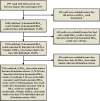Toward a Clinically Actionable, Electronic Health Record-Based Machine Learning Model to Forecast 90-Day Change in Hemoglobin A1c in Youth With Type 1 Diabetes: Feasibility and Model Development Study
- PMID: 40997334
- PMCID: PMC12463387
- DOI: 10.2196/69142
Toward a Clinically Actionable, Electronic Health Record-Based Machine Learning Model to Forecast 90-Day Change in Hemoglobin A1c in Youth With Type 1 Diabetes: Feasibility and Model Development Study
Abstract
Background: Clinicians currently lack an effective means for identifying youth with type 1 diabetes (T1D) who are at risk for experiencing glycemic deterioration between diabetes clinic visits. As a result, their ability to identify youth who may optimally benefit from targeted interventions designed to address rising glycemic levels is limited. Although electronic health records (EHR)-based risk predictions have been used to forecast health outcomes in T1D, no study has investigated the potential for using EHR data to identify youth with T1D who will experience a clinically significant rise in glycated hemoglobin (HbA1c) ≥0.3% (approximately 3 mmol/mol) between diabetes clinic visits.
Objective: We aimed to evaluate the feasibility of using routinely collected EHR data to develop a machine learning model to predict 90-day unit-change in HbA1c (in % units) in youth (aged 9-18 y) with T1D. We assessed our model's ability to augment clinical decision-making by identifying a percent change cut point that optimized identification of youth who would experience a clinically significant rise in HbA1c.
Methods: From a cohort of 2757 youth with T1D who received care from a network of pediatric diabetes clinics in the Midwestern United States (January 2012-August 2017), we identified 1743 youth with 9643 HbA1c observation windows (ie, 2 HbA1c measurements separated by 70-110 d, approximating the 90-day time interval between routine diabetes clinic visits). We used up to 5 years of youths' longitudinal EHR data to transform 17,466 features (demographics, laboratory results, vital signs, anthropometric measures, medications, diagnosis codes, procedure codes, and free-text data) for model training. We performed 3-fold cross-validation to train random forest regression models to predict 90-day unit-change in HbA1c(%).
Results: Across all 3 folds of our cross-validation model, the average root-mean-square error was 0.88 (95% CI 0.85-0.90). Predicted HbA1c(%) strongly correlated with true HbA1c(%) (r=0.79; 95% CI 0.78-0.80). The top 10 features impacting model predictions included postal code, various metrics related to HbA1c, and the frequency of a diagnosis code indicating difficulty with treatment engagement. At a clinically significant percent rise threshold of ≥0.3% (approximately 3 mmol/mol), our model's positive predictive value was 60.3%, indicating a 1.5-fold enrichment (relative to the observed frequency that youth experienced this outcome [3928/9643, 40.7%]). Model sensitivity and positive predictive value improved when thresholds for clinical significance included smaller changes in HbA1c, whereas specificity and negative predictive value improved when thresholds required larger changes in HbA1c.
Conclusions: Routinely collected EHR data can be used to create an ML model for predicting unit-change in HbA1c between diabetes clinic visits among youth with T1D. Future work will focus on optimizing model performance and validating the model in additional cohorts and in other diabetes clinics.
Keywords: AI, artificial intelligence; EHR, electronic health records; HbA1c, hemoglobin A1c; T1D, type 1 diabetes; adolescent; clinical decision support; glycemic control; machine learning; pediatric; population health; prediction; real-world data; youth.
© Erin M Tallon, David D Williams, Cintya Schweisberger, Colin Mullaney, Brent Lockee, Diana Ferro, Craig A Vandervelden, Mitchell S Barnes, Angelica Cristello Sarteau, Anna R Kahkoska, Susana R Patton, Sanjeev Mehta, Ryan McDonough, Marcus Lind, Leonard D'Avolio, Mark A Clements. Originally published in JMIR Diabetes (https://diabetes.jmir.org).
Conflict of interest statement
Figures



References
Grants and funding
LinkOut - more resources
Full Text Sources
Research Materials

